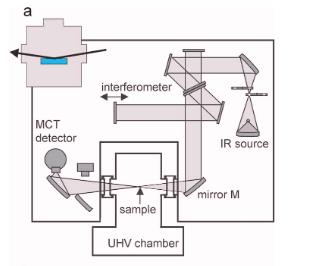Characterization of the adsorption geometry of halogenobenzene derivatives on metal surfaces by FTIR spectroscopy
To understand the mechanisms of heterogeneous catalysis in detail, the adsorption of organic molecules on metal surfaces is investigated. A well-established method for this system is the Fourier-transform Infrared spectroscopy, in which the absorption of infrared light induces vibrations of the adsorbed molecules.
In this project, we investigate halogenated benzene derivatives, e.g. chloro- and bromo-benzene, on copper single-crystals by reflection-absorption Infrared spectroscopy (RAIRS). The sensitivity of this method enables the investigation of ultra-thin layers down to sub-monolayers. Restricted by selection rules, only vibrations perpendicular to the surface can be detected. Thus, the molecules’ adsorption geometry can be concluded in dependence of the coverage of the surface and the adsorption temperature. In addition, the influence of different substituents at the benzene ring and their interaction with the surfaces is examined.
Got interested? Contact christina.pentzek@rub.de
IR Spektroskopie:


